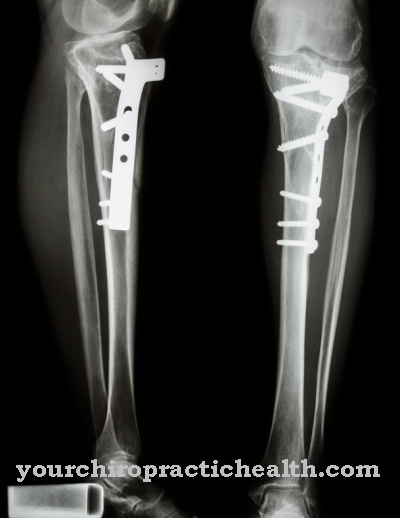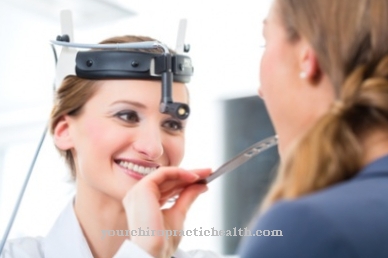Of the Bing test is one of several known subjective hearing test methods in which certain tuning fork tests with reduced hearing performance can be used to determine whether a one-sided sound conduction or sound sensation disorder is present. The Bing test uses the different hearing sensation between bone and airborne sound with alternating closure and reopening of the external auditory canal.
What is the Bing test?

The Bing test is usually carried out using the Rydel and Seiffer tuning fork, which was specially designed for tuning fork hearing tests and neurological vibration tests. Like all tuning fork tests, the Bing test is relatively easy to perform. If a one-sided hearing loss is suspected, a Bing test can be used to determine whether there is a sound conduction problem or a sound perception problem. The tuning fork is struck and the foot of the fork is held firmly on the bone process of the temporal bone behind the auricle (mastoid process) and the external auditory canal is alternately closed and reopened with the finger.
If there is no change in hearing between the briefly closed and opened ear canal, there is a sound conduction disorder. If the tone of the tuning fork is heard much louder with the ear canal closed, then there is a sensorineural disorder in the affected ear. Since an effect of the same quality at an overall higher volume level occurs with normal hearing people, the hearing ability, e.g. B. by tone audiogram, to avoid misinterpretations. The Bing test was originally known as faux bing, i.e. false bing.
When the foot of the vibrating tuning fork is placed on the center of the skull of a patient with a unilateral conduction disorder, the patient hears the sound louder in the disordered ear. If the normal hearing ear is now also closed with the finger, the sound does not travel to the other side to the "healthy" ear, whose auditory canal is now closed with the finger, but the patient still hears the sound louder with the ear with the conductive disorder .
Function, effect & goals
When testing hearing impairments, it is not just a matter of how much the hearing sensation is reduced, but in terms of a subsequent targeted therapy or technical support for hearing, the distinction between sound conduction and sound sensation disorders is extremely important. A sound conduction disorder occurs when a link in the transmission chain has functional disorders in the “mechanical” part of the hearing organ, which includes the outer ear and the ossicles of the middle ear.
A sound sensation disorder occurs when one of the components in the "electrical" part of the hearing process, which includes the conversion of mechanical sound waves into electrical nerve impulses in the inner ear, the transmission of the signals to the CNS and the further processing of the signals in the CNS, has a functional disorder . A sound that mainly reaches the ear via the skull bones is called bone or structure-borne sound. Like the sound transmitted through the air and the external auditory canal, it sets the eardrum and ossicles in vibration. In this case, however, part of the vibration energy is thrown back from the eardrum, so that overall there is a weakening of the volume.
If the external auditory canal is closed, the part of the sound emitted from the eardrum into the eardrum is reflected back onto the eardrum (in this case by the finger). The patient or test person can now hear the sound transmitted by structure-borne noise much louder. The Bing test makes use of this phenomenon, which is also known as the occlusion effect. The Bing test is used in patients with unilateral hearing impairment and provides clarity as to whether there is a sound conduction or a sound sensation disorder. Behind the auricle of the ear with the hearing impairment, the foot of the struck tuning fork is held firmly on the bony process of the temporal bone (mastoid process) and the external auditory canal is closed and reopened several times with the finger.
If the patient does not perceive a difference in the volume of the sound between the closed and the unlocked phase of the auditory canal, there is a sensorineural disorder. The sensorineural disorder can have several causes, either there is a disorder of the sensory cells in the cochlea in the inner ear so that the mechanically incoming sound is not properly translated into electrical nerve impulses or the transmission line, the auditory nerve (vestibulocochlear nerve), has a disorder on or the signals cannot be processed properly in the brain into corresponding auditory impressions.
You can find your medication here
➔ Medicines for earache and inflammationRisks, side effects & dangers
All known tuning fork methods for checking hearing - including the Bing test - are carried out non-invasively and completely free of chemicals or drugs. The Bing test is also pain-free and has no side effects. Any risks and dangers are not known. The test results of the Bing test, which are of a more qualitative nature due to their subjectivity, can be supplemented by an objective method with quantitatively comparable values. These are impedance measurements of the eardrum.
The most important procedure is tympanometry, in which the external ear canal is closed and a test tone is emitted into the ear canal. The reflection of the eardrum is then measured at different pitches, tone strengths and at different pressures in the external auditory canal from slightly overpressure to slightly negative pressure. In this way, the different values between structure-borne and air-borne noise can also be evaluated quantitatively. It should be noted that the subjective Bing test, like the other tuning fork tests, can provide important qualitative statements about the presence of a sound conduction or a sound sensation disorder, but that further objective diagnostic methods with quantifiable parameters are recommended if the results are positive.

























.jpg)

.jpg)
